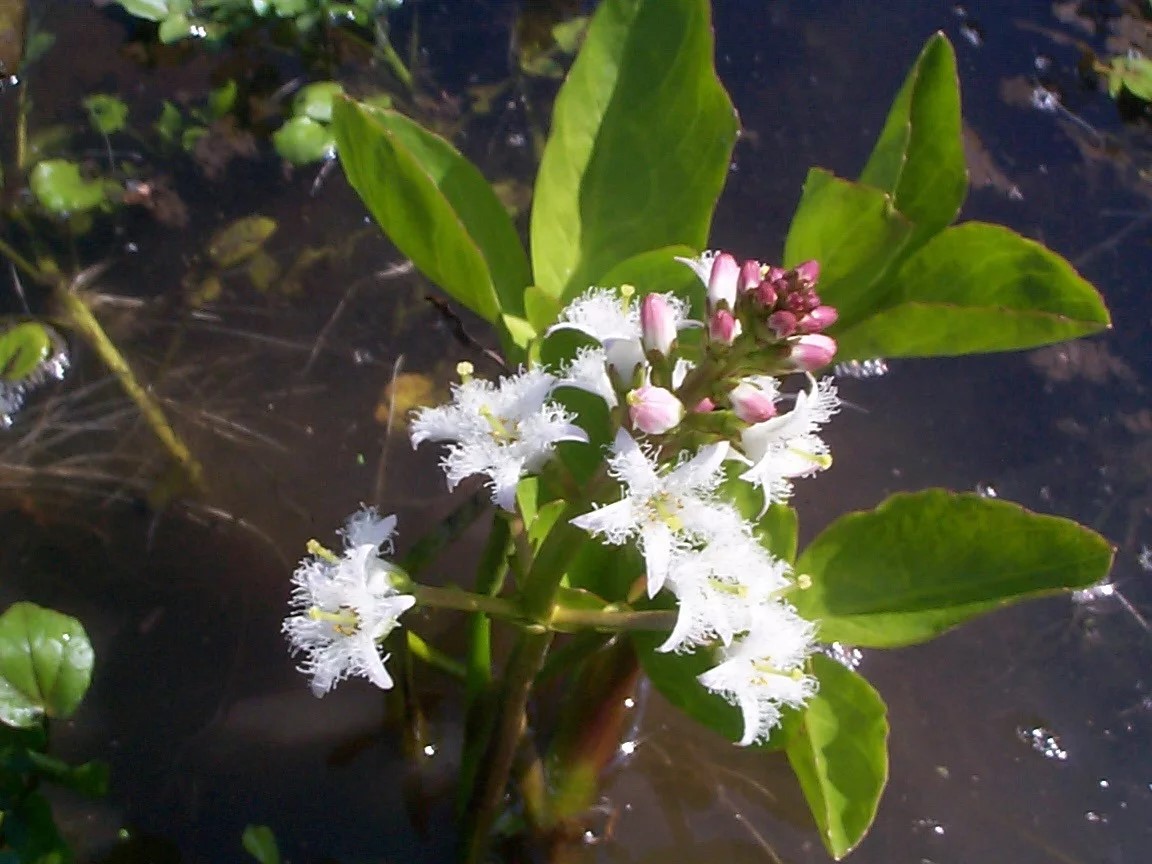Family: Menyanthaceae
Genus: Menyanthes
Species: trifoliata
Common Names:
-
English: Buckbean, Bogbean, Water Trefoil, Marsh Clover
-
Dutch: Bocksboonan
-
German: Bitterklee, Fieberklee
Parts Used: Herb, Leaves
Habitat:
Buckbean thrives in bogs, marshes, and shallow wetlands throughout Europe, Asia, and North America. It is particularly common in Northern England and Scotland and less so in Southern regions. It flourishes in wet, peaty soils and is often seen adorning the edges of ponds and bogs.
Botanical Description:
Menyanthes trifoliata is a glabrous (smooth, hairless) perennial plant, known for its horizontal creeping rhizome and alternate trifoliate (three-parted) leaves.
-
Height: 15–45 cm (6–18 inches)
-
Leaves: On long, fleshy, grooved petioles; each divided into three entire (non-serrated) leaflets about 5 cm (2 inches) long.
-
Flowers: Appear in dense, upright racemes, blooming from May to July. The flowers are star-like, with pale rose-pink exteriors and fuzzy white interiors with reddish stamens, making them visually striking.
-
Seeds: Produced after flowering, completing the life cycle.
Medicinal Properties and Uses:
Buckbean is highly regarded in herbal medicine for its diverse therapeutic applications:
Key Actions:
-
Tonic
-
Cathartic (purgative)
-
Deobstruent (clears obstructions)
-
Febrifuge (reduces fever)
-
Anti-inflammatory
-
Carminative (relieves flatulence)
-
Digestive
-
Astringent
-
Emmenagogue (stimulates menstrual flow)
-
Diuretic
-
Hypnotic (mild sedative)
Traditional Medicinal Uses:
-
Digestive Tonic: Closely related to gentians, it is used to stimulate appetite, support digestion, and improve overall vitality, especially in cases of weakness and weight loss.
-
Rheumatism & Arthritis: Used especially when symptoms are associated with debility and poor digestion.
-
Skin and Blood Conditions: Historically valued for treating rheumatism, scurvy, skin eruptions, and gout.
-
Fever and Dropsy: The fresh juice of the leaves was traditionally mixed with whey for treating dropsy (edema) and reducing fever.
-
Herbal Tobacco: The dried leaves have also been smoked in herbal blends.
-
Ague Remedy: The finely powdered leaves have a reputation for breaking fever cycles (ague) when other treatments fail.
-
Combination Uses: Often combined with herbs like celery seed (Apium graveolens) and white willow (Salix alba) for arthritic and inflammatory conditions.
Cautions:
-
Should not be used in cases of diarrhea, dysentery, colitis, or gastric inflammation as it may aggravate these conditions.
-
The fresh plant is emetic (induces vomiting) and should be carefully prepared and dried before medicinal use.
Conclusion:
Menyanthes trifoliata is a striking wetland plant with significant historical and medicinal importance. From digestive stimulation to rheumatism relief, it has been a valuable addition to herbal pharmacopeias. Despite its therapeutic benefits, it requires careful use and should be avoided in sensitive digestive conditions.
Speech Disorder
A speech disorder, also known as a speech impairment...
ADHD
Attention-deficit / hyperactivity disorder (ADHD) is a...
Cerebral Palsy(CP)
Cerebral palsy (CP) is a group of neurological disorders...
Cancer
Cancer is a broad term for diseases where cells...




